#alaska mosquito nets
Text

Window Nets For Insects
Alaska Services
Ph: 8807000685
We are pioneers in the field of mosquito net fixing.
The biggest strength of our company is that we meet the quality standards in material, customer support and punctuality.
1 note
·
View note
Text
We're currently in the height of our mosquito season in Interior Alaska; every time I go outside I get bit. Being easy prey for mosquitoes is a problem I've always had, so while my labmates are getting swarmed, I'm happily sweltering in my permethrin soaked pants, rain jacket, and head net. It's 100% A Look, and might be a bit overkill, but i no longer spend evenings in a benadryl coma. I've already convinced 1/5 others about the head net.
Also the bug bite thing (which is a syringe that draws bug venom back out of a bite) is fantastic, easy to use, and entirely worth the $10.
I cannot wait for the start of the snow season, because that's the only thing that drives the mosquitoes away :(
1 note
·
View note
Text
Surviving Alaska: Mosquitoes
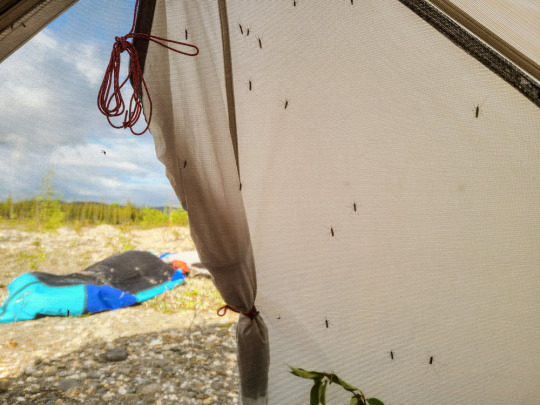
Many an ode has been written on these critters. Threats to wipe out their entire population are frequently expressed on some camping trips. The vast tundra swarms with them and they are impossible to escape. Such annoyance in a 2.5mg package, it’s a wonder they cause such discontent. Some 17 trillion mosquitoes call Alaska home so a quick calculation reveals a total mosquito weight of 96 million pounds! Each female is capable of drawing 5mg of blood so it’s a wonder there are any of us left.
DEET has been around for nearly a century now. It was first developed in 1944 and entered military service in 1946. It is highly effective but comes with some drawbacks. It smells bad, leaves a sticky residue and can melt plastics. Using deet means you have to be careful around watches and wrist/neck gaskets on drysuits. It comes in many different concentrations from 10% to 100%. Always buy 40-50% which is the most repellant and least toxic; anything above 50% studies show is not more effective. As one of the most effective and well-known insect repellants it has staying power but there is a newer option that you should be aware of.
Picaridin was developed in 2001 and has gained widespread use. You may not have heard of the compound but it is often marketed as a “family friendly” insect repellent. The reason being, it is less toxic, nearly odorless, and does not melt plastic. It is most effective at 20% concentration. It is still not as easy to find as deet but is available at most stores if you look around. Studies show that it works just as well as deet in mosquito deterrence. This is now my go-to bug spray.
Permethrin is used in bug nets, tents, and some clothing. It is not to be used as a spray on the skin. It does actively kill insects and is highly effective. However it will wash out after a few cycles and needs to be reapplied. Reapplication is time consuming, akin to extending the life of your tent fly with waterproofing spray. Repellents like eucalyptus oil and other natural remedies may be slightly effective but usually less so and for a shorter period of time.
Don’t forget clothing. 2 soft layers (Apline Fit base layer plus a midlayer) is usually enough. Of course a dry suit is bomb proof on a packrafting trip, but a rain jacket will suffice. A bug net is essential on most trips in Alaska. Have a way to keep the bug net off your face, especially the ears which are easily forgotten.
For those that have experienced the interior of Alaska, there really isn’t anything like it. On a recent trip down the John river we descended from Alpine terrain in cold conditions to full summer early mosquito hatch. We couldn’t get our bug nets secure enough or into our tents fast enough. They found every potential opening and our hands swelled with cumulative bites. Sometimes the repellants just aren’t enough. We came by several long-abandoned hunting cabins and even an old town. Built by intrepid gold miners 100 years ago, they have not seen use in decades. It’s not hard to imagine what might have driven these early explorers out.
0 notes
Text
Sunday, March 19, 2023 Canadian TV Listings (Times Eastern)
WHERE CAN I FIND THOSE PREMIERES?:
LUCKY HANK (AMC Canada) 9:00pm
WHAT IS <i>NOT</i> PREMIERING IN CANADA TONIGHT?:
CALL THE MIDWIFE (PBS Feed)
SANDITION (PBS Feed)
MARIE ANTOINETTE (PBS Feed)
THE CASES OF MYSTERY LANE (TBD - Lifetime Canada)
LGT WORLD WOMEN’S CURLING CHAMPIONSHIP
(TSN3) 11:00am: United States vs. Canada
(TSN3) 2:00pm: Canada vs. Norway
NCAA MEN’S BASKETBALL
(TSN4) 12:00pm: March Madness: Second Round
(TSN4) 6:00pm: March Madness: Second Round
(TSN) 8:00pm: March Madness: Second Round
(TSN3) 10:00pm: March Madness: Second Round
(TSN5) 11:30pm: March Madness: Second Round
NHL HOCKEY
(SN) 1:00pm: Bruins vs. Sabres
(SN) 4:00pm: Blue Jackets vs. Knight
(TSN3) 7:00pm: Jets vs. Blues
(SNPacific) 8:00pm: Canucks vs. Ducks
NBA BASKETBALL
(SN1) 3:30pm: Nugget vs. Nets
(SN1) 8:00pm: Raptors vs. Bucks
NCAA WOMEN’S BASKETBALL (TSN4) 4:00pm - 11:30pm: March Madness: Second Round
TENNIS
(TSN2) 4:00pm: WTA 1000 Tennis: Indian Wells - Final
(TSN2) 7:00pm: WTA 1000 Tennis: Indian Wells - Final
WBC BASEBALL (SN/SN360) 7:00pm: Semifinal 1
BEST IN MINIATURE (CBC) 7:00pm: The judges see who’s hungry for the win as the artists make their mini desert island dishes and wrestle with the most difficult room in the house, the kitchen.
SULLIVAN'S CROSSING (CTV) 7:00pm (SERIES PREMIERE): When neurosurgeon Maggie Sullivan's seemingly perfect life in Boston is turned upside down, she leaves the city and her boyfriend, Andrew, to return to her childhood home of Sullivan's Crossing in Nova Scotia.
A YEAR ON PLANET EARTH (CBC) 8:00pm (SERIES PREMIERE): Winter: Earth’s journey around the Sun begins – whilst the north is frozen in darkness, for the south this is the season of light.
THE INVENTOR: OUT FOR BLOOD IN SILICON VALLEY (CNN) 8:00pm: With a new invention that promised to revolutionize blood testing, Elizabeth Holmes became the world's youngest self-made billionaire, heralded as the next Steve Jobs. Then, just two years later, her multibillion-dollar company was dissolved.
ESSEX COUNTY (CBC) 9:00pm (SERIES PREMIERE) Eleven-year-old Lester grapples with his mother’s death and finds out his long-absent dad may be closer than he knew. Anne takes on caring for her estranged uncle Lou, who is haunted by his past.
ALL THE BEAUTY AND THE BLOODSHED (HBO Canada) 9:00pm: Rare footage and intimate interviews provide insight into the life and work of renowned photographer and activist Nan Goldin.
SPRING BREAK NIGHTMARE (Super Channel Fuse) 9:00pm: A woman travels to an island paradise when her daughter, Kayla, goes missing during a spring break trip with friends. As she tries to deal with the kidnappers' demands, she soon learns that Kayla may have been betrayed by those closest to her.
RENOVATION RESORT (HGTV Canada) 10:00pm: Creativity is put to the test in the third cabin challenge, as the teams head upstairs to turn the loft into a dual-purpose flex space; Savannah and Kyle create a family-friendly cosmic space while Rotem and Troy build a hidden room.
THE CURSE OF OAK ISLAND (History Canada) 10:00pm: As the garden shaft operation gets deeper, the evidence of gold gets stronger.
PORTRAIT ARTIST OF THE YEAR (Makeful) 10:00pm: Suggs, Miquita Oliver, Eve Muirhead
ALASKA AND BEYOND: BIG AND SMALL (Nat Geo Canada) 10:00pm: The awe-inspiring diversity of Alaska's animal wildlife, from the mosquito to the bald eagle.
OUTBACK OPAL HUNTERS (Discovery Canada) 10:00pm: The Blacklighters realize a long-held dream with the purchase of an excavator, while the Young Guns struggle for air trying to open a ventilation shaft 14 meters underground.
AQUA TEEN FOREVER: PLANTASM (adult swim) 12:00am: Everyone's favorite rascals Frylock, Master Shake, Meatwad and Carl fight the corporate overlord Amazin, led by tech mogul Neil and his trusty scientist sidekick, Elmer.
#cdntv#cancon#canadian tv#canadian tv listings#best in miniature#sullivan's crossing#a year on planet earth#essex county#renovation resort#the curse of oak island#portrait artist of the year#outback opal hunters#curling#ncaa basketball#nba basketball#tennis#wbc baseball
0 notes
Text
Airstreaming to Alaska - Chapter 11: Yukon
Long dusty roads. Midnight sun. Thick wildfire smoke. Rivers rising to the breaking point. Cell signal outages. Moose crash hot zones. Every morning we untangled our weary bones from the mosquito net to resume the ongoing discussion, "Should we turn back"
Posted December 4, 2022 – Narrated by Carmen
To listen to the podcast, click the play button
Chapter 11 of the “Airstreaming to Alaska” series.
“This is the Law of the Yukon, that only the Strong shall thrive;That surely the Weak shall perish and only the Fit survive.Dissolute, damned, despairful, crippled and palsied and slain.This is the will of the Yukon – Lo, how she makes it…
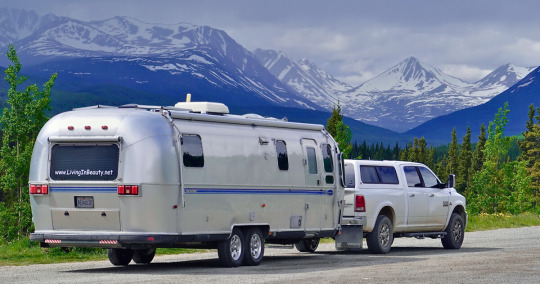
View On WordPress
#Airstream#Airstream Blog#Airstream Life#Airstream Travel Blogs#Airstreaming#atlin#Beaubeaux#Full-time Airstreaming#Full-time RV Living#Full-Time RVing#Living in Beauty#living simply#Living the Dream#simple living#teslin#watson lake#whitehorse#yukon
0 notes
Text

One of the untold dramas of the Alaska Gold Rush was the building of the Alaska Railroad. In today’s dollars, it cost $7.5 billion but only benefitted 3,663 people.
That’s ridiculous! So what’s the true story?
The United States Navy needed coal for its ships in the Pacific Ocean. Before the construction of the Alaska Railroad, that coal had to be shipped by rail across the United States to seaports in Los Angeles, San Francisco, Portland and Seattle. But with the Alaska Railroad, the coal was less than 236 miles from a Pacific Ocean port.
And the next time you think about coming to Alaska during the summer and going camping, keep in mind the mosquitoes are so thick you will have to wear netting like these men.
[From THE HUMAN FACE OF THE ALASKA GOLD RUSH.]
👉Learn more: https://authormasterminds.com/details/3DwEy
👉Watch the short video: https://youtu.be/mocJb-YivXU
SteveLevibooks #readersandwritersbookclub #authormasterminds #thrillers #Mysteries #crimebooks
0 notes
Photo
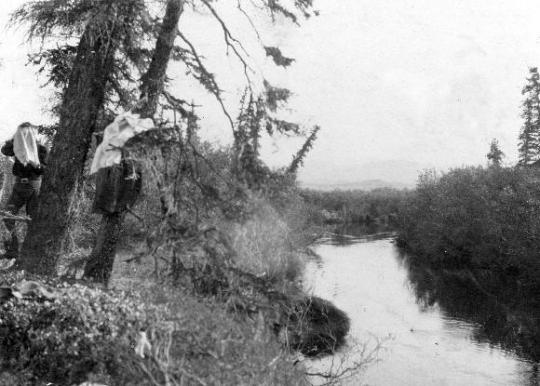
“Old Man Creek near camp in flats. Dall District, Ajukon Region, Alaska. 1901.“
Mendenhall Collection
USGS Denver Library Photographic Collection Library ID: mwc00197
1 note
·
View note
Text
'Insect apocalypse' may not be happening in US
https://sciencespies.com/nature/insect-apocalypse-may-not-be-happening-in-us/
'Insect apocalypse' may not be happening in US
Scientists have been warning about an “insect apocalypse” in recent years, noting sharp declines in specific areas — particularly in Europe. A new study shows these warnings may have been exaggerated and are not representative of what’s happening to insects on a larger scale.
University of Georgia professor of agroecology Bill Snyder sought to find out if the so-called “insect apocalypse” is really going to happen, and if so, had it already begun. Some scientists say it might be only 30 years before all insects are extinct, so this is a really important and timely question for agriculture and conservation.
Snyder and a team of researchers from UGA, Hendrix College and the U.S. Department of Agriculture used more than 5,300 data points for insects and other arthropods — collected over four to 36 years at monitoring sites representing 68 natural and managed areas — to search for evidence of declines across the United States.
Some groups and sites showed increases or decreases in abundance and diversity, but many remained unchanged, yielding net abundance and biodiversity trends generally indistinguishable from zero. This lack of overall increase or decline was consistent across arthropod feeding groups, and was similar for heavily disturbed versus relatively natural sites. These results were recently published in Nature Ecology and Evolution.
Local observations
The idea for the study started last year with a cross-country road trip for Snyder from Washington state to his new home in Georgia.
advertisement
“I had the same observation a lot of people had. We had our drive across the country — you don’t see as many insects squished on your car or windshield.”
When he got to his home in Bishop, Georgia, it seemed like a different story.
“I noticed the lights outside were full of insects, as many as I remember as a kid,” he said. “People have this notion — there seems like [there are] fewer insects — but what is the evidence?”
There is some alarming evidence that European honey bees have problems, but Snyder was curious if insects everywhere are in decline. “We depend on insects for so many things,” he said. “If insects disappear it would be really, really bad. Maybe the end of human existence.”
He was discussing the topic with another biologist and friend, Matthew Moran at Hendrix College, and they recalled the U.S. National Science Foundation’s network of Long-Term Ecological Research (LTER) sites, which were established in 1980 and encompass a network of 25 monitoring locations across each of the country’s major ecoregions.
advertisement
Ecological sampling
The NSF’s LTER data is publicly available, but has not previously been gathered into a single dataset to be examined for evidence of broad-scale density and biodiversity change through time until now.
Arthropod data sampled by the team included grasshoppers in the Konza Prairie in Kansas; ground arthropods in the Sevilleta desert/grassland in New Mexico; mosquito larvae in Baltimore, Maryland; macroinvertebrates and crayfish in North Temperate Lakes in Wisconsin; aphids in the Midwestern U.S.; crab burrows in Georgia coastal ecosystems; ticks in Harvard Forest in Massachusetts; caterpillars in Hubbard Brook in New Hampshire; arthropods in Phoenix, Arizona; and stream insects in the Arctic in Alaska.
The team compared the samples with human footprint index data, which includes multiple factors like insecticides, light pollution and built environments to see if there were any overall trends.
“No matter what factor we looked at, nothing could explain the trends in a satisfactory way,” said Michael Crossley, a postdoctoral researcher in the UGA department of entomology and lead author of the study. “We just took all the data and, when you look, there are as many things going up as going down. Even when we broke it out in functional groups there wasn’t really a clear story like predators are decreasing or herbivores are increasing.”
“This is an implication for conservation and one for scientists, who have been calling for more data due to under-sampling in certain areas or certain insects. We took this opportunity to use this wealth of data that hasn’t been used yet,” explained Crossley, an agricultural entomologist who uses molecular and geospatial tools to understand pest ecology and evolution and to improve management outcomes. “There’s got to be even more data sets that we don’t even know about. We want to continue to canvass to get a better idea about what’s going on.”
Good and bad news
To answer Snyder’s broad question of, “Are there overall declines?” No, according to the study. “But we’re not going to ignore small changes,” Snyder said. “It’s worthwhile to differentiate between the two issues.”
Particular insect species that we rely on for the key ecosystem services of pollination, natural pest control and decomposition remain unambiguously in decline in North America, the authors note.
In Europe, where studies have found dramatic insect declines, there may be a bigger, longer-term impact on insects than the U.S., which has a lower population density, according to Snyder.
“It’s not the worst thing in the world to take a deep breath,” suggested Snyder. “There’s been a lot of environmental policies and changes. A lot of the insecticides used in agriculture now are narrow-acting. Some of those effects look like they may be working.”
When it comes to conservation, there’s always room for everyone to pitch in and do their part.
“It’s hard to tell when you’re a single homeowner if you’re having an effect when you plant more flowers in your garden,” he said. “Maybe some of these things we’re doing are starting to have a beneficial impact. This could be a bit of a hopeful message that things that people are doing to protect bees, butterflies and other insects are actually working.”
#Nature
0 notes
Text

Window Mosquito Net
Alaska Services
Ph: 8807000685
We are pioneers in the field of mosquito net fixing.
The biggest strength of our company is that we meet the quality standards in material, customer support and punctuality.
0 notes
Link
David Brodosi
- The great part about
Alaska camping
is that it is definitely your best bet for an inexpensive vacation. Tent campers will need a good quality tent with an intact mosquito net, rain fly and waterproof bottom, as well as lightweight sleeping mats and sleeping bags. In Alaska, campsites abound on state, national park sites, commercial sites, or just off in the bush. Alaska state law does not prohibit camping by the side of the road. Other possibilities for roadside camping are the many turnouts, rest areas marked by rectangular blue signs and scenic viewpoints. All these can make good campsites. The rest areas sometimes have signs saying, “No overnight camping allowed.”
Camping with the Bears
Never bring food into your tent. When in bear country, pack all food inside your vehicle and cover it. Don’t leave even crumbs outside, or you can (and probably will) expect unwelcome and potentially dangerous late night visitors. If you are backpacking, put food in a covered container a good distance from your tent and cache in a tree if possible. Check out our
Bear Safety
page for more information.
Denali Campgrounds:
Camping in Denali offers a great way to experience this spectacular park. There are five established campgrounds in the park. You may camp a total of 14 days per year in Denali National Park & Preserve’s established campgrounds. Riley Creek Campground, at the entrance of the park is open year-round. Denali’s campgrounds all have different access, fees, and facilities. (click on any of the campgrounds above to obtain more information about that campground)
See
Denali Campground Map
. See the
Milepost camping
page. They have a list with all of the campsites in Alaska. See the State of
Alaska camping page
and make reservations.
Camping with our state bird: The Mosquito:
Mosquitoes are more than a nuisance in the summer in the north country; they are a genuine problem. Be vigilant. Keep your windows rolled up, enter and exit the vehicle quickly and close the doors, or dozens of the little devils will enter in a minute. Don’t park near water for picnics or overnight, if possible. Beware of walking into the shade. Mosquitoes love the shade. Buy high-quality bug repellent and purchase mosquito coils, available in most general merchandise stores in Alaska. Burn a coil for 20 minutes while you are out of the vehicle; that will kill the mosquitoes. It doesn’t smell too good, though. Don’t become a mosquito dinette: wear a long-sleeved shirt and pants.
For more see our
Mosquitoes
page
David Brodosi
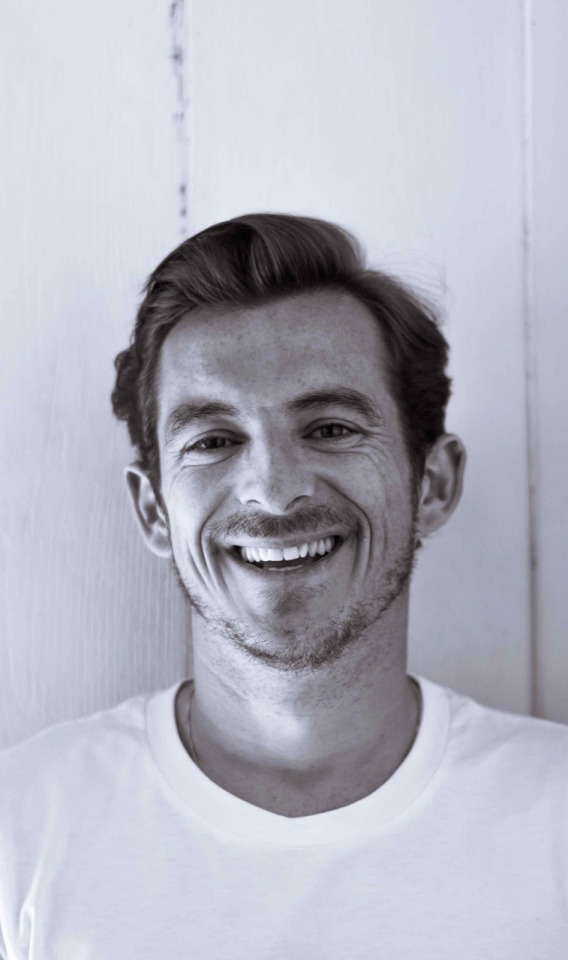




0 notes
Text
Arctic Heat
By Mike, Matteo, Martina and Vincent
Almost done with filtering water and collecting bacterial laden sediment from the icy stream, we felt sleepy. A yawn would come to each of us occasionally. Replying to the rhetorical question of “what time is it?” a slow voice replied “10 minutes to midnight”. We finished the sampling process of our first glacier, packed everything in a slow pace and hiked down the valley to our base camp after a very long day, with a fatigued dose of satisfaction. In few hours were to set out again but our Greenlandic sampling campaign was finally happening.
Spirits were not the same in the previous week upon arrival in Greenland’s capital, Nuuk. Martina Schoen, our fourth member complemented now our team and we were all confident that everything was prepared to the highest possible detail for Vanishing Glaciers second expedition in Greenland. In Nuuk, and despite the historically record-breaking warm summer, we were confronted to the Arctic chill ourselves right on the first day. The liquid nitrogen containers that after many logistical efforts were finally sent from Denmark to Nuuk were already there waiting for us… but completely empty. Our excitement evaporated, as did this vital to our research gas, during its voyage through the Atlantic.
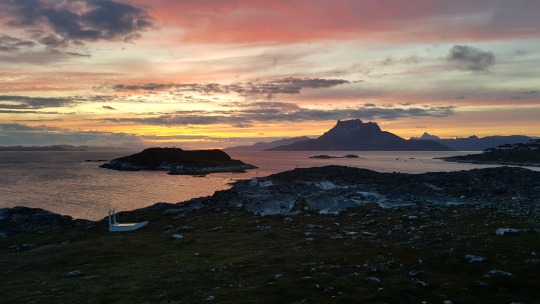
Arctic nights’ scenery was a good antidote to the logistical headaches encountered during our first dully week in Nuuk (Photo © Vincent De Staercke)
On top of that, the cargo with our scientific equipment sent 15 days ago from Lausanne was stuck for a week in Kangerlussuaq airport, as Air Greenland was operating with half their fleet due to technical problems. “Logistics are not easy in the Arctic” was a statement that echoed in our ears repeatedly and from different people. We had no reason to disagree. Brief moments of desperation gave place to action, as in these tight moments the only way is moving forward, seeking or improvising solutions. Without a deep freezing agent, name it liquid nitrogen or dry ice, there was not a chance for the expedition to happen. To the upside of these days of uncertainty and grief, were the help and support of scientists from the Greenlandic survey - Asiaq and the Greenland Institute of Natural Resources - GINR, the kindness of the locals and the arctic scenery.

Our targeted glaciers in Kobbefjord seemed so close but they were still quite far, during the long wait of our equipment and dry ice to arrival to Nuuk. (Photo © Mike Styllas)
TØRIS… meaning dry ice in Danish language sounded like the only solution to our problems. Had we not worked with dry ice in Valsorey valley in Switzerland, as part of SBER’s ENSEMBLE project, we would not have so much faith in this deep freezing agent. A couple of more days of overcoming logistical hurdles and there we were finally sailing to Ameralik fjord for the first round of sampling glacier-fed streams of Greenland’s peripheral glaciers.
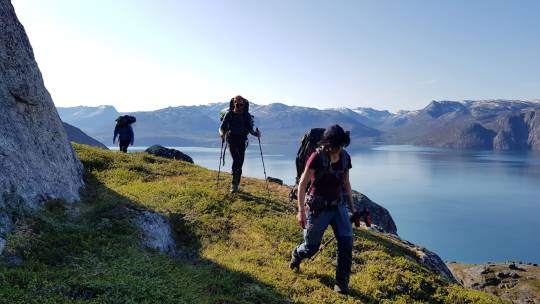
Finally, after nearly a week of uncertainty the team is back in action. Ameralik Fjord (Photo © Vincent De Staercke)
The glaciation regime in Greenland is special. The generator of climate, at least for the most of the northern hemisphere, was entirely covered by ice as long as 20,000 years ago. As we moved to the interglacial conditions of the past 10,000 years, the ice sheet remained relatively intact, but in the smaller ice caps, local glaciers were left behind in the Greenlandic periphery. During modern times, and the era of increasingly human pressure on Earth’s natural cycles, these peripheral glaciers despite their maritime setting did not escape the ongoing climate change and have been losing about 50Gt of ice every year for the past decade (Zemp et al., 2019. Nature 568, 382–386, https://www.nature.com/articles/s41586-019-1071-0).

Glacier meltwater discharging in Ameralik Fjord. Meltwater runoff from Greenland’s peripheral glaciers has doubled over the past 20 years. (Photo © Vincent de Staercke)
To put this in plain numbers, every year the Greenlandic peripheral glacier meltwater can fill an empty Lake Constance (volume approximately 48Gt). These peripheral glaciers were the target of our expedition as they are now vanishing in very fast pace; according to the World Glacier Monitoring Service (WGMS) database, the ice front of Chamberlain glacier that we sampled in Disko island, has retreated 2.5km within the last century! Another natural testimony of these rapid changes is manifested by the formation of lakes in front of the glaciers, which in the hiking maps or in previous satellite images were not present.

A newly formed lake and a fresh exposed moraine along the ice front of a glacier in Kobbefjord. The lake formed over the last few years and is an undisputed proof of the ongoing rapid loss of ice from Greenland’s glaciers (Photo © Vincent De Staercke)
Once on the field, things were more straightforward. The team coherence and previous experience with the great outdoors were tested through the long hikes in the Arctic tundra, a place where marked and established trails are not the norm. In this part of the world things are still wild and walking in such an unmarked territory gives a sweet taste of isolation. Mosquitos posed an annoying company during the first days but nets and adjustability made these invertebrates to be just a company, disappearing once we were approaching the glaciers’ snouts. The scenery and the biodiversity of the Arctic tundra are amazingly beautiful and all the ingredients for a successful expedition were finally there.

Sampling site near the glacier terminus in Ameralik fjord. (Photo © Vincent De Staercke)
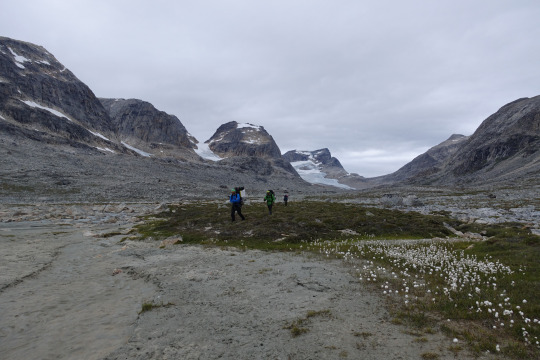
Long hikes in the Arctic tundra through valleys with high biodiversity, became the norm of Vanishing Glaciers Greenland expedition. (Photo © Martina Schoen)
Day after day, we would go deeper in the valleys, sample the glacier-fed streams and return to our base camp, nested near the local shelters, where we kept our dry ice depo for storing the samples. Upon supper, we would analyze the plan the next day and head to our tents for a well-deserved rest with the Arctic light omnipresent this time of year.

Our base camp at the bottom of Tuapassuit valley with Ameralik fjord in the background. (Photo © Matteo Tolosano)
During our field campaign along the west coast of Greenland, we were to encounter the warmest summer of the instrumental record. News kept coming from all around the world about very high temperatures in Greenland, accompanied by extremely high glacier melt discharge into the Atlantic Ocean, and about unusually large and intense wildfires in Alaska and Siberia, producing unprecedented high amounts of CO2. Not having direct measurements ourselves we tested the heatwave soaring Greenland as well, by using our bodies as a water temperature gauge. Coming down from our sixth glacier in Kobbefjord, we did find a lake partly detached from the glacial stream, and what a pleasure was to take a swim under the shinning sun in the Arctic!

Climatological data claim that this is the warmest summer of the instrumental record. The environmental deterioration caused by the unpreceedentent temperatures was a surprise to us as well. If we are able take a swim just below the glaciers in Greenland, something is going wrong with climate (Photo © Vincent De Staercke).
Once done with sampling of the selected glaciers in Ameralik fjord and Kobbefjord, both located in the vicinity of Nuuk, it was time to extend our sampling transect past the Arctic Circle and headed north, to Disko Island. The trip with the ferryboat was relaxing, the sea was calm, but despite our observatory desire to spend excess time on the deck, whales were nowhere to be seen.
Things changed rapidly once we arrived in Ilulissat and traversed to Disko Island. Disko Bay welcomed us with heaps of icebergs coming out from the ice cap, while whales were playful enough to complete our vision of the Arctic dream. Another intense week followed, long hikes in the glacial valley just to the east of Qeqertarsuaq, but the scenery in these volcanic glaciated deserts was different from what we had encountered before.

The whales were abundant in front of the Arctic Station in Disko Island. Here a humpback whale swimming among the icebergs. (Photo © Matteo Tolosano).

Pjetursson Glacier was the 10th glacier we sampled in Greenland. The glacier front in the year 1910 was in the position where this photo is taken (Photo © Mike Styllas)

World Glacier Monitoring Service (WGMS) observations of Pjetursson glacier frontal variations. Glacier retreat of 2km within the last century is fact not to be overseen.
Our stay in the Arctic Station was another pleasant surprise, meeting with scientific teams from Denmark and Switzerland. The setting of the Arctic Station is truly amazing and the hosts were very helpful and polite. Evening discussions about the ongoing interdisciplinary projects were definitely an act that opens one’s mind to different horizons, and were complemented by exchanges of experiences from scientific projects that have taken place in other parts of the world. Interactions with the local communities are also easy. It was interesting to learn from the locals how the environment has been changing over the last decades. It is not only the glacial ice that melts fast over the past 20 years, but also the sea-ice, which in Disko Bay was appearing by the end of October and now forms in January and melts again by April.
Glacier meltdown, delayed formation of the sea ice, dry tundra and swimming in lakes confess that the Arctic Heat is here and happening.

The football field and the helipad in front of the Arctic station. Football is very important in Greenland but do not miss the ball, as the swim to get it back will be a bit cold (Photo © Martina Schoen).
We concluded our fieldwork campaign in nearly perfect weather, reaching our initial goals. Samples were sent back to our lab in Lausanne and during our last days in Greenland, the preparations of our equipment for the follow-up expedition to Caucasus Range intensified.
Our Greenland expedition was another foray in the classroom along the course of Vanishing Glaciers scientific odyssey. Despite the Arctic chill we felt running down our spines as high voltage electricity once faced with the liquid nitrogen empty tanks, we managed to accomplish what we came here for.
The climatically very warm summer, was for us a good touch of the Arctic Heat as well; but this is something to be seriously taken into account, as the pressure on the ice cap, the glaciers, the sea ice and the tundra ecosystems is obvious. The warmth of the local people and scientists made it a very special experience, where all difficulties were finally overcomed. We are particularly thankful to Kirsty Langley and Jacob Aberman from Asiaq, to Thomas Petersen and Lars Heilmann from GINR for their invaluable help and support.
Mike, Matteo, Martina and Vincent
0 notes
Photo

Thank you Sreevani, Nadine & Rev. Joy for knocking the ThermoCell Mosquito Protection Lantern, FotoPro Flexible Tripod, Alaska Guidepost Travel Planer and mosquito head net off of my Amazon Wish list. These are all going to come in super handy going to and from Anchorage and bunch of other backcountry spots across in the US! Thank you!!! Oh...these products were all suggested by @lifestyleoverland . Their YouTube channel rocks! missionforhope #overlanding #jeepin #jeeps #camping #backcountry http://bit.ly/2WdtkVT
0 notes
Text
theghostparty replied to your post: I just spent almost an hour looking up random...
there was an airbnb in taiwan that i saw which was literally a yoga mat on someone’s roof with a mosquito net over it
on the opposite side of the spectrum, my favorite find so far was a yacht in alaska you could rent for $10k a night
3 notes
·
View notes
Text
Naked, Afraid and Transgender: ‘The Wilderness Couldn’t Care Less’
Editor’s note: Quince Mountain is the first openly transgender person to be on “Naked and Afraid,” Discovery’s reality TV show in which participants try to survive 21 days in the wilderness. His episode debuted this month.
I’m lying under an uneven canopy of foliage, sharp gravel digging into my back. I try not to think of the jungle rain as unceasing. I try to feel it, drop by drop. Sometimes a drop hits a spot where my skin is cut or burned away, and I feel a little thrill.
I am camped along the bank of the Corinto River, in a rain forest in Atlántida, Honduras, and have been for nine days. I’m alone: the partner I started this 21-day challenge with went home five days ago.
This is miserable, but I feel fortunate. Growing up knowing I was a boy when everyone around me considered me a girl — and not a very good one — already taught me how to survive alone. Being naked in this remote jungle is a relief. The wilderness couldn’t care less who I am.
I’ve always been a physical person, but team sports were fraught with gender problems since grade school. Over the years, I’ve discovered the joys of outdoor adventure, spending almost as much time with animals as with humans. First, I rode horses, traveling alongside a team and wagon and rounding up cows on ranches in western South Dakota. These days my wife and I spend our time living and camping with a team of dogs in Alaska, Canada and the upper Midwest.
It’s a big deal to be a trans person out in the public square who is able to act rather than simply being acted upon. In appearing on “Naked and Afraid,” I want to show what I can accomplish, without having to deal with people questioning my credentials. I want to show what trans people can accomplish. With new laws restricting access to bathrooms, locker rooms and shelters, physical attacks on trans people on the rise, according to advocacy groups, and federal legislation threatening safeguards for the transgender rights that do exist, I want to shout: “Just leave us alone!”
But first, I have to survive.
My possessions include a heavy survival knife; a magnesium bar and fire starter rod; a wedding band; some cord I made from twisted strings of plant fiber; a mosquito net with a few holes burned in it; several underripe tree nuts; and a hollowed out drinking gourd that’s rotting, but still usable.
I don’t have a compass, or clothes, or shoes, or anything to entertain myself with in the dark. If I had a smartphone I would probably be using it to play the puzzle game Two Dots, as I would if I were in line at Target.
When I told friends I was going on “Naked and Afraid,” they worried I’d be rendered a caricature. Isn’t reality television all about confining formulas? I told them it’s here, stripped down for this naked TV show, that I can be real. That my experience growing up as a trans person was the fictional performance.
I was raised to act as a person I was not. When I said I was a boy, or presented myself as one, I was told I was lying, that I was a girl. One of my deepest truths, my sense of self, is something I had to lie about.
It’s a tough bind. We are either betraying the truth by not being ourselves, or we dress and move through the world in ways that feel right, and then are told that we’re lying. The real truth, people insist, is hidden underneath our clothes.
Out here, there are no clothes, nor lies I have to live, and I’m as exposed as I can be.
A cameraman named Derek arrives at my shelter.
“Is this a bit like Chinese water torture, then?” he asks in his Scottish accent.
“Excuse me?”
“Would you describe this as torture — feeling cold rain fall through the roof of your shelter and knowing it could last all night?”
I like Derek. I tell him this is nothing like torture. Every second that I’m here, I’m choosing to be here.
“Good,” he says.
I fall asleep on my mosquito net atop my prickly gravel bed. An hour later I’m suddenly awake — biting ants!
The ants are coming from the chunk of wood I just put on the fire. When the wood got too hot, the ants made a break for the floor of my shelter. They were under attack and they began to bite me. I can’t blame them.
I have to get off the mosquito net, shake it out, and flick any ants off my body, all in the dark. This is annoying, but I’ve already developed a routine for it.
I’m getting used to the simplicity of suffering here. There is none of the nonsense I endured growing up at odds with gender norms.
No one here has knocked me to the pavement. No one is kneeling over me spraying shaving cream in my eyes. No one is riding away on my bicycle, off to dump it in the creek.
I am not in fourth grade, opening the door to a house that has been ransacked by a playmate who lives down the street. There’s no broken glass, no shattered record albums, no vomit left in my bedroom. There’s no mailbox and no note in that mailbox explaining why my family deserved to have our home trashed, explaining that I’m a “rotten boy-girl,” a “he-she,” an “it.”
For all the jungle’s indifference to my well-being, I am free from many quotidian worries. No one is telling me I’m too aggressive, bad for team cohesion. No one is asking for an ID card. No one is asking about my name. I’m naked, but no one cares about my junk. I am not thinking about bathroom stalls, and I’m not thinking about how to explain myself to employers, or distant family or anyone else.
Here, there is a knife. There is a fire, and there is a river. No one is in my way.
Sahred From Source link Arts
from WordPress http://bit.ly/2xa7yap
via IFTTT
0 notes
Text
Pet Dog Cat Bed Puppy Cushion House Warm Kennel Sofa Mat Pad Blanket Washable
New Post has been published on http://catstuff.space/pet-dog-cat-bed-puppy-cushion-house-warm-kennel-sofa-mat-pad-blanket-washable/
Pet Dog Cat Bed Puppy Cushion House Warm Kennel Sofa Mat Pad Blanket Washable
STORE CATEGORIES Store Home Home & Garden Hammocks Home Dcor&Candle Holders Kitchen, Dining & Bar Men’s Backpacks, Bags & Briefcases Women’s Backpacks & Bookbags Pet Supplies Store Newsletter Add my Store to your Favorites and receive my newsletters about new items and special promotions! HOT SALE Double 2 Person Cotton Rope Hanging Hammock $18.90 BUY IT 3X Clear Plant Hanging Vase Flower Terrarium Container $9.99 BUY IT Pet Dog Cat Bed Puppy Cushion House Warm Kennel Sofa Mat Pad Blanket Washable Feature: 100% Brand new and high quality Made of high quality short plush, thick warm fabric Adopt soft warm cotton cloth on the wall, washable and durable With breathable, moisture-proof non-woven bottom Create a comfortable bed for your pet’s healthy sleeping and rest It is super soft and warm, so your pet will feel happy when in it Best bedroom or resting place for your pet dog or cat,Lovely strawberry style, simple but good-lookingNote :Not Machine WashableAs a result of long-term compression, please take the goods inside the filling smooth even fluffy reuse Specification: Material: Oxford cloth + Fleece+PP Cotton For: large ,medium and small pets Colors: Blue,Coffee,Dark Green,Grey,Orange,Pink Filling: three-dimensional PP cotton For:dogs,cats Size: S:17.7*13.8inch,Suitable for pets less than 5kg/11lb M:22.8*17.7inch, Suitable for pets less than 10kg/22lb L:26.8*21.7inch, Suitable for pets less than 15kg/33lb XL:31.5*25.6inch,Suitable for pets less than 25kg/55lb XXL:37.4*29.5inch, Suitable for pets less than 28kg/62lb XXXL:43.3*33.5inch, Suitable for pets less than 35kg/77lb Package included: 1 x Pet Bed ABOUT US PAYMENT SHIPPING Policy Contact ABOUT US About Us Welcome to our ebay store. Panda-9966 is committed to providing each customer with the outstanding customer service, the highest quality products and a comfortable, secure shopping environment online. Our products are supplied directly from the manufacturer so that it can enable us to offer quality product with best price for you. *Quality Guarantee All our products have been done strictly quality inspection & test by our QC Team. Meanwhile,all items have been checked by customs and paid customs duties before they shipped to our USA warehouse. Please rest assured to purchase. If any defective products you received, please contact us, a refund or replacement will be processed. *Fast Delivery Deliver lead time is significantly shorter as our shipping department is located in Ohio(Our USA Warehouse), United States; All US lower 48 state orders will be handled same day if payment received by 12:00 P.M Pacific Time. Tracking numbers will automatically be updated same day. *Service Guarantee We strive for 100% customer satisfaction! 100% customers satisfaction guarantee,if you have any issue, please do not hesitate to contact us, we will work hard to solve your problem. Feedback We will be greatly appreciated your positive feedback and five star DSRs on eBay.If you are not satisfied with your purchase, please do contact us before leave negative feedback. We will spare our efforts to solve your problem. It’s our commitment to providing you enjoyable shopping experience. PAYMENT 1.We accept PayPal only 2.All payments must be received within 10 days after auction won 3.Non-pay bidder will get a negative feedback and an unpaid alert from eBay 4.E-checks via Paypal will be hold until it is cleared SHIPPING Shipping Free Shipping within the 48 States. We ship within the United States only. The term EXCLUDES the states of Alaska, Hawaii and all off-shore U.S. territories and possessions such as Puerto Rico, Guam and Virgin Islands. We do not ship to APO and FPO. Delivery Time: 3-7 business days (Varies by Destination) Shipping Carriers are responsible on the delivery time. If you have any questions or problems with delivery, please contact carrier directly Standard Order Processing time: All items will ship within 24 hours (Monday – Friday). Payment cleared/received on Friday will be shipped on the next business days (Monday or Tuesday) We are not responsible for carrier transit time. This information is provided by the carrier and excludes weekends and holidays. Note that transit times may vary, particularly during peak periods or in climate weather conditions, and that delivery times frames will need to be extended for any processing time frames in excess of 1-2 business days. Policy Return/Exchange Replace/return are available if buyers receive wrong/damaged/defective items. For replacement or return , buyer should keep the item in acceptable packing. Before replace or return ,buyer should submit proof to us by pics if possible. Please keep in mind that spending time before purchasing the part to confirm it is indeed exactly what you need can help prevent you from ordering the wrong part. Anyway ,by nice communications ,we can find a way to make you satisfied Shipping Damage Shipping damage is any item/package suspected of being broken or damaged in anyway during the shipping process. We purchase full insurance for this, however the damage must be reported to us within 3 days of receiving the package. Contact US Contact Via eBay message system, you will get our response as soon as it is read. Please send all correspondence through the ebay messaging system. All Technique questions, must be asked via ebay message. Message will be applied during business hours: 9AM to 6PM Pacific Time. Monday to Friday only (excluding Holidays). After hours messages will be replied on the next business day. MAY YOU LIKE 3 6 10 Vampire Devil Red Wine Glass Cup $10.98-31.98 BUY IT Double Person Mosquito Net Hammock $31.98 BUY IT Men’s Leather Laptop Shoulder Briefcase Messenger Bag $25.49 BUY IT Pet Cat Dog Magnetic Lock Flap Door Gate S M L SIZE $11.95-15.95 BUY IT Inflatable Travel Car Air Mattress $28.96 BUY IT Copyright panda-9966. All Rights Reserved.
0 notes